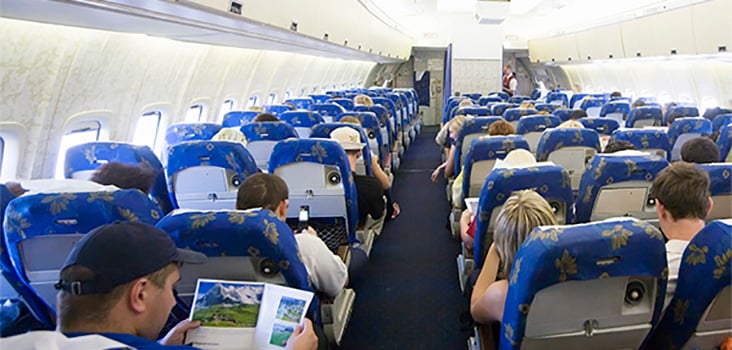
Preparing for Air Travel When You Have a Chronic Illness
Air travel is considered a very safe means of transportation. Over one billion people travel by commercial aircraft annually. These numbers are expected to double in the next twenty years. Illness as a direct result of air travel is uncommon. Nevertheless, there are some health considerations that can improve the quality of an air traveler’s health during flight. We will review these potential health risks and measures you can take to improve your health as you travel by air, even during prolonged flights crossing three or more time zones.
Major health risks during flight are those caused by:
- Worsening of already diagnosed chronic medical illness due to changes in air pressure during flight (jet cabins are typically pressurized to 8,000 feet above sea level).
- Close proximity to other passengers with certain communicable diseases during flight.
- Relative immobility during prolonged flights (increasing risk of blood clotting in the legs)
Travelers with chronic illnesses should:
- See their health care provider to make sure that their medical condition is stable for air travel.
- An annual influenza vaccine is recommended.
- Avoid travel to remote destinations.
- Carry a physician’s letter on official letterhead stationery, outlining medical diagnoses, medications prescribed and medical equipment needed to manage the condition.
- Consider choosing a medical assistance company that stores your medical history before departure for international access. In addition, consider trip cancellation and medical evacuation insurance(www.insuremytrip.com is one travel insurance search engine)
- Pack medications and medical supplies in carry-on luggage in their original containers.
- Carry copies of all prescriptions as well as enough quantities for the entire trip plus extra in case of unforeseen delays. Consider keeping a second supply of medication in checked baggage in case of loss.
- Review schedules of medications with your provider. Some medications need to be taken based on elapsed time and not necessarily time of day when changing time zones.
- Stay well hydrated (drink plenty of water and avoid caffeine and alcohol as they can be dehydrating).
- Wear loose fitting clothing and walk and stretch at regular intervals to keep active and to help avoid blood clotting.
- If you require supplemental oxygen during flight then notify the airline more than 72 hours before departure. Federal regulations require the airline to supply the oxygen in flight. Some airlines or destinations may not supply supplemental oxygen. Travelers are responsible for providing their own oxygen supplies on the ground before departure, during layovers, and upon arrival. See this helpful link to the National Home Oxygen Patient Association.
Medical Contradictions to Flight
There are some medical reasons to avoid or postpone air travel. These reasons are primarily due to changes in air pressure during flight. See the list below. Consult your health care provider if you have any of these conditions or any other questions or concerns.
Conditions
- Blood: severe anemia of any cause.
- Cardiovascular diseases: unstable angina (chest pain at rest due to blocked arteries), recent heart attack (< two weeks or advice of cardiologist), severe congestive heart failure, uncontrolled high blood pressure, coronary bypass <14 days, stroke <14 days angiogram (<2 days), uncontrolled abnormal heart rhythm, severe symptomatic disease of heart valves.
- Gastrointestinal diseases: surgery, including laparoscopic, within 10-14 days, gastrointestinal bleeding within 24 hours, colonoscopy within 24 hours, partial bowel obstruction, liver failure
- Lung diseases: severe asthma, recent hospitalization for severe respiratory illness, active lung infection, collapsed lung within 14 days, fluid surrounding lungs (pleural) within 14 days, chest surgery within 10-14 days, high supplemental oxygen requirements at baseline.
- Neurological conditions: recent severe head injury, particularly with bleeding in or around the brain, swelling of the brain due to a tumor or any other cause
- Surgery: for any recent surgery consult your surgeon, particularly if recent abdominal, brain, cranial, chest, or eye surgeries
- Pregnancy: most commercial airlines prohibit pregnant women from flying after 35 weeks or earlier and may require documentation of gestational age
Other Flight Considerations
Barotrauma: Because commercial airliners are pressurized to approximately 8000 feet above sea level, barotrauma may occur when the air pressure inside an air-filled space in our body (middle ear, sinuses, abdomen) changes and becomes different from the air pressure inside the plane cabin. These changes tend to occur during more rapid changes in air pressure such as take-off and landing.
Barotrauma most commonly affects the middle ear, when the Eustachian tube blocks on descent and is unable to equalize the inner ear air pressure with the outside cabin air. This is usually mild and the pain typically passes within minutes of landing. Perforated ear drums, dizziness and ringing of the ears are rare. Symptoms may be alleviated by yawning, close nosed swallowing and chewing gum. Those with bad sinus, nose or ear infections or congestion may want to consult their physician prior to travel to prevent pain or injury.
Oral pseudoephedrine one hour before flight or a decongestant nasal spray may also help those with nasal and ear infections. Travelers should also stay hydrated by drinking plenty of water to help prevent dry mucous membranes and promote better function of the Eustachian tubes. Caffeine and alcohol are dehydrating and should be avoided during prolonged air travel or those with upper respiratory infections. Children are especially susceptible to changes in middle ear pressure. Eating or drinking during descent can help equalize air pressure in the Eustachian tube and middle ear thereby preventing or alleviating pain.
Ventilation, Air Quality and Infectious Disease
Approximately 10-50% percent of the air on commercial airliners is mixed with outside air and then recirculated after filtration twenty to thirty times per hour. The recycled air on newer airplanes is now filtered through high efficiency particulate air (HEPA) filters which capture 99.9 % of particles such as bacteria, fungi and larger viruses or virus clumps. The air flow then circulates transversely across limited bands of seats and does not circulate up and down the plane. This limits the spread of most infectious diseases during air travel. Occasionally, contact with infected secretions can occur with coughing or sneezing or by touching a contaminated surface then touching one’s face with contaminated hands.
Practice good hand washing and use hand sanitizers as needed while traveling. Cover your cough and face while sneezing to prevent the spread of infection. If a passenger with a communicable disease is identified after flying on a commercial flight, passengers who may have been exposed may be contacted by public health authorities and offered intervention if needed.
The average humidity of the recirculated air in flight is typically 10-20%. This dry air may dry mucous membranes of the nose and mouth. To avoid dehydration on long flights drink plenty of water and avoid excessive alcohol and caffeine which are dehydrating.
We wish you safe and pleasant travels!
Travelers planning trips outside of Western Europe, Canada, Australia and New Zealand should seek the advice of a travel health specialist four to six weeks prior to departure. Your travel health specialist will provide:
- Recommended and required vaccines
- Prescriptions to prevent or self-treat common travel-related illnesses
- Health and safety counseling tailored to your specific itinerary, activities, and medical history



